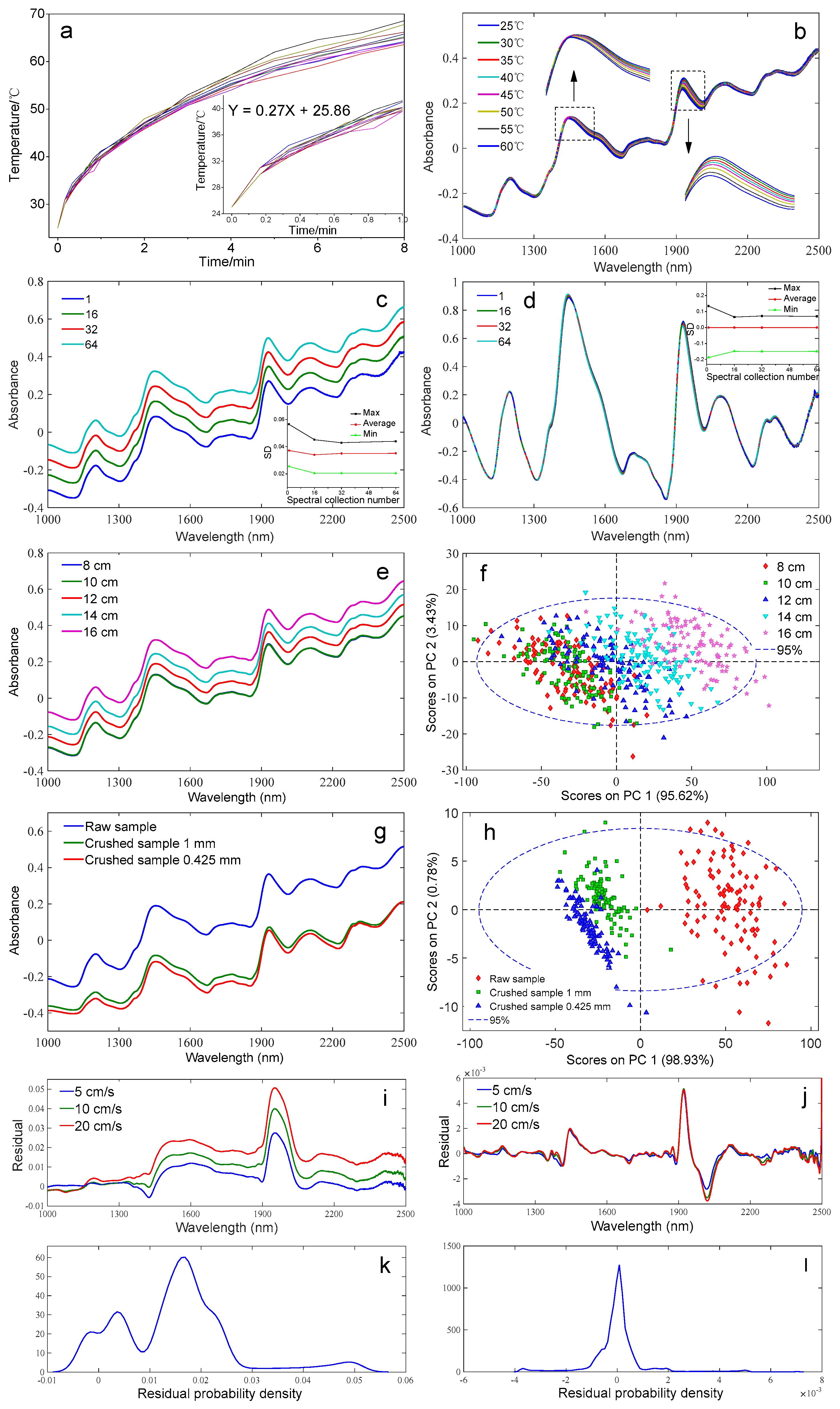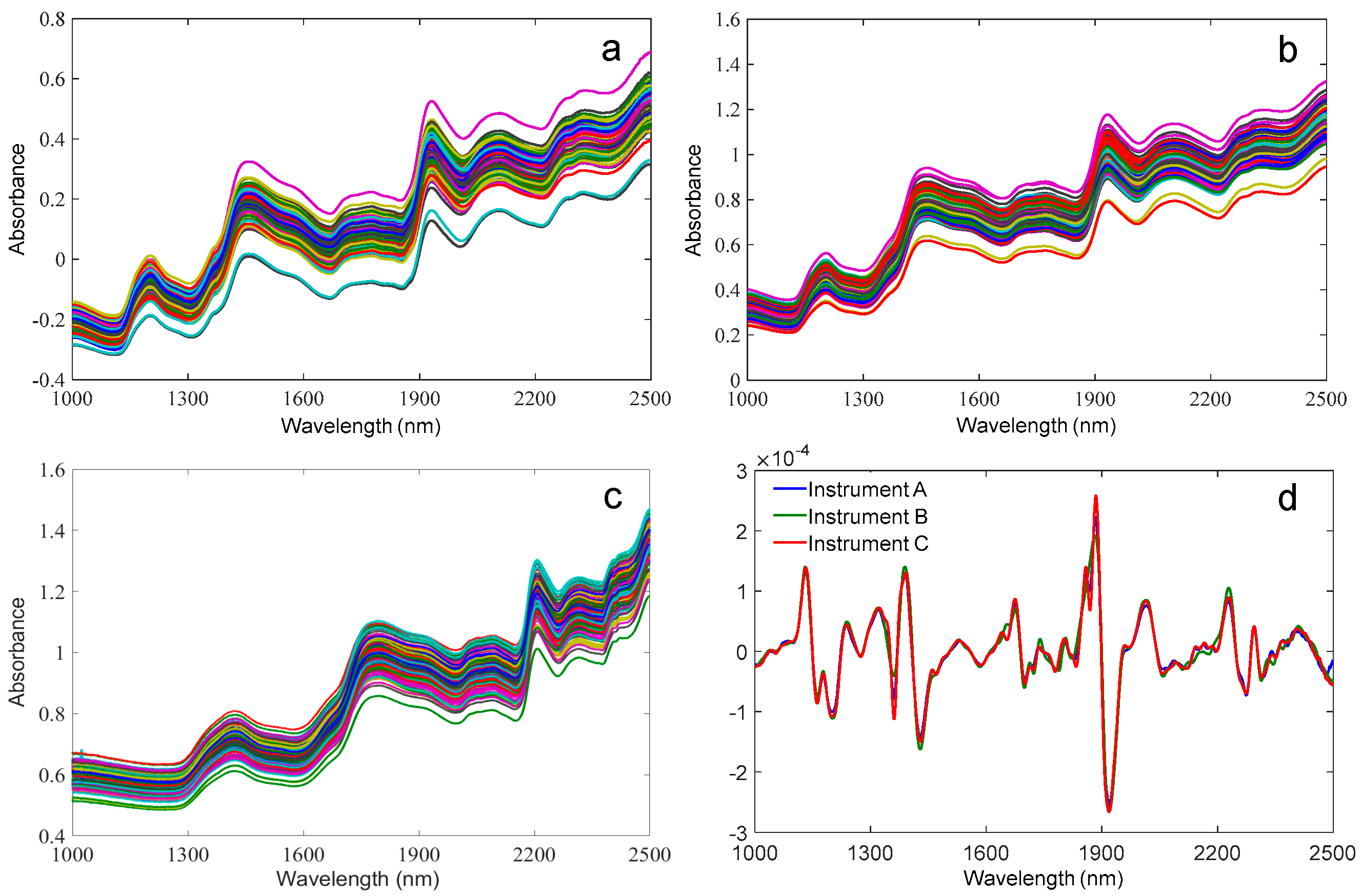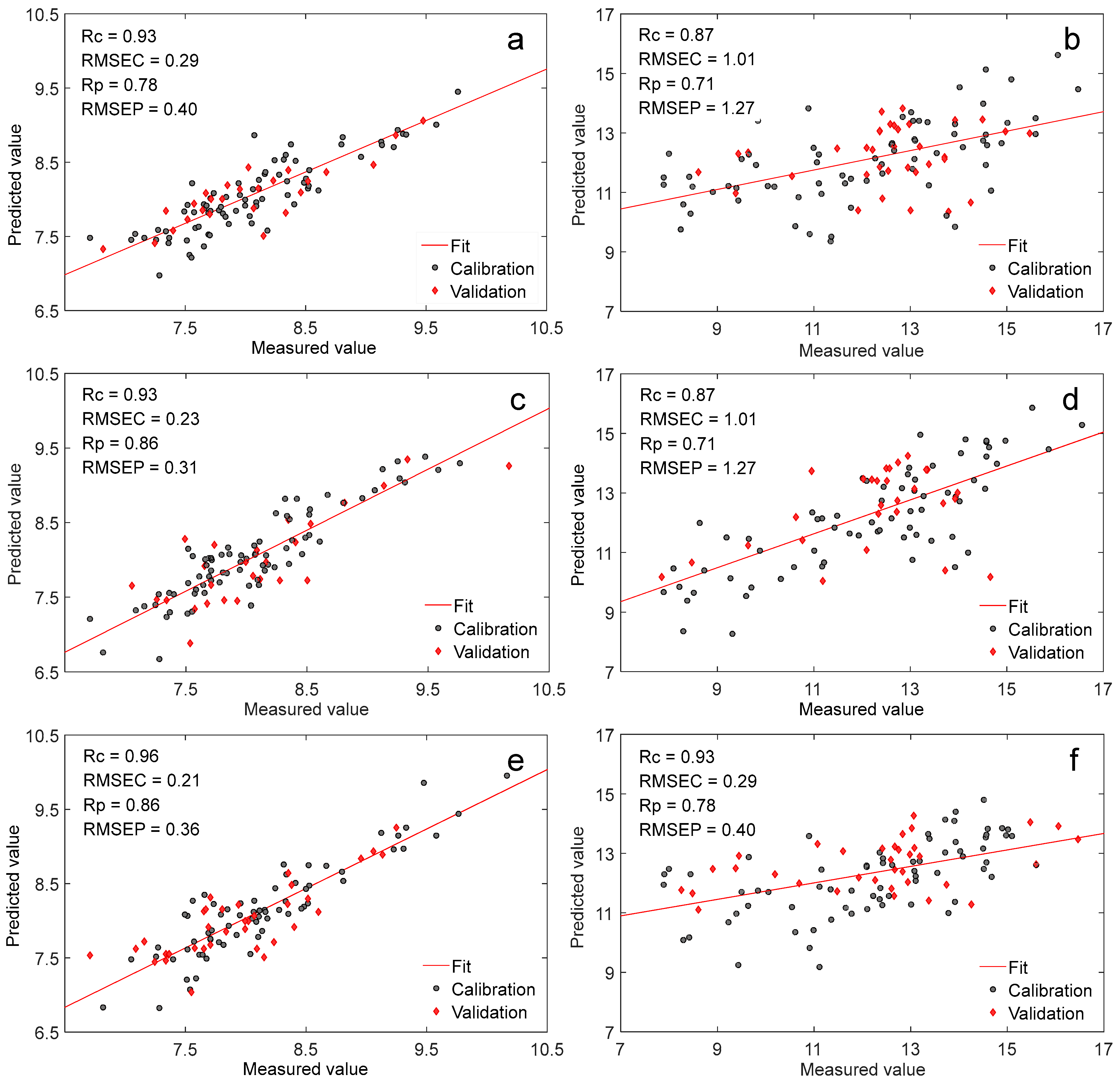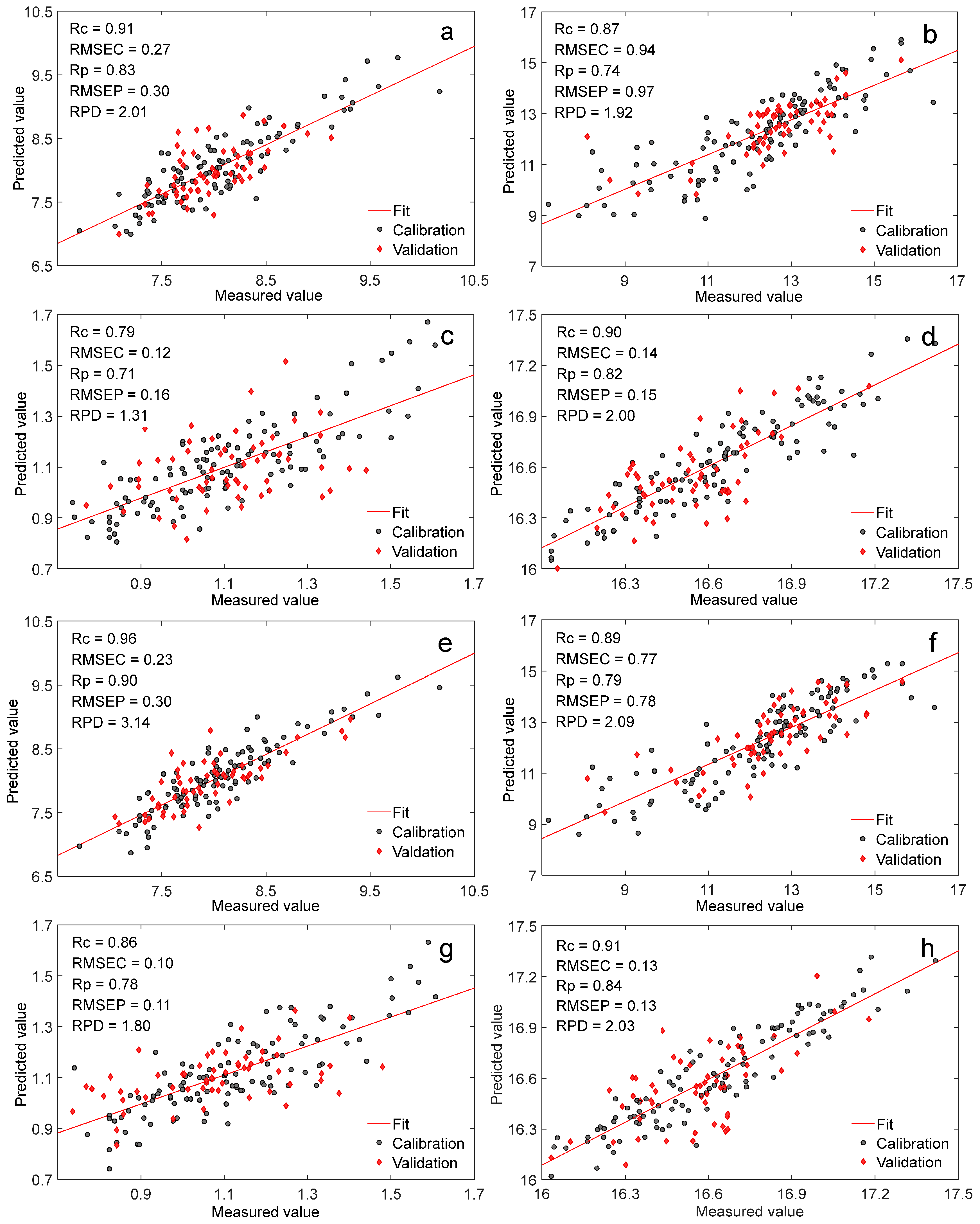A Study of the Reliability and Accuracy of the Real-Time Detection of Forage Maize Quality Using a Home-Built Near-Infrared Spectrometer
Abstract
:1. Introduction
2. Materials and Methods
2.1. Sample Preparation
2.2. Experimental Analysis of Forage Maize Quality
2.3. NIR Spectroscopy Systems
2.3.1. Different NIR Spectrometers
2.3.2. Spectra Acquisition
2.4. Analysis of Influence Factors for NIR Online Spectrometer
2.4.1. Sample Surface Temperature
2.4.2. Different Number of Spectra Scans
2.4.3. Different Detection Optical Paths
2.4.4. Different Particle Sizes
2.4.5. Different Conveyor Speeds
2.4.6. Orthogonal Experiment of Influence Factors of NIR Online Analysis
2.5. Data Processing and Analysis
3. Results and Discussion
3.1. Parameter Analysis of NIR Spectra Collection
3.1.1. Variation of Surface Temperature and Spectral Absorption during Sample Scanning
3.1.2. Effect of Different Number of Scans on NIR Spectral
3.1.3. Effect of Different Detection Optical Paths on NIR Spectra
3.1.4. Effect of Different Particle Sizes on NIR Spectra
3.1.5. Effect of Different Conveyor Speeds on NIR Spectra
3.1.6. Parameter Optimization of Influence Factors of NIR Online Analysis
3.2. Establishment and Comparison of Forage Maize Model Using Three Different NIR Spectrometers
3.2.1. Component Analysis of Forage Maize
3.2.2. Spectral Characteristics of Different NIR Spectrometers
3.2.3. Comparative Analysis of Models of Different NIR Spectrometers
3.3. Validation Analysis of NIR Online System for Forage Maize Quality Detection
3.3.1. Component Statistics of Forage Maize
3.3.2. Establishment of NIR Online Model for Forage Maize Quality
3.4. Verification for Practical Application of NIR Online Model for Forage Maize Quality
3.4.1. Repeatability Analysis of NIR Online Model for Forage Maize
3.4.2. Accuracy Analysis of NIR Online Model for Forage Maize Quality
4. Conclusions
Supplementary Materials
Author Contributions
Funding
Data Availability Statement
Conflicts of Interest
References
- Rudel, T.K.; Paul, B.; White, D.; Rao, I.M.; Van Der Hoek, R.; Castro, A.; Boval, M.; Lerner, A.; Schneider, L.; Peters, M. LivestockPlus: Forages, sustainable intensification, and food security in the tropics. Ambio 2015, 44, 685–693. [Google Scholar] [CrossRef] [PubMed] [Green Version]
- Williams, P.J.; Geladi, P.; Britz, T.J.; Manley, M. Investigation of fungal development in maize kernels using NIR hyperspectral imaging and multivariate data analysis. J. Cereal Sci. 2012, 55, 272–278. [Google Scholar] [CrossRef]
- Saha, U.; Endale, D.; Tillman, P.G.; Johnson, W.C.; Gaskin, J.; Sonon, L.; Schomberg, H.; Yang, Y. Analysis of various quality attributes of sunflower and soybean plants by near infrared reflectance spectroscopy: Development and validation calibration models. Am. J. Anal. Chem. 2017, 8, 462. [Google Scholar] [CrossRef] [Green Version]
- Godfray, H.C.J.; Aveyard, P.; Garnett, T.; Hall, J.W.; Key, T.J.; Lorimer, J.; Pierrehumbert, R.T.; Scarborough, P.; Springmann, M.; Jebb, S.A. Meat consumption, health, and the environment. Science 2018, 361, eaam5324. [Google Scholar] [CrossRef] [Green Version]
- Gao, F.; Zhou, S.; Han, L.; Yang, Z.; Liu, X. A novel FT-IR spectroscopic method based on lipid characteristics for qualitative and quantitative analysis of animal-derived feedstuff adulterated with ruminant ingredients. Food Chem. 2017, 237, 342–349. [Google Scholar] [CrossRef]
- Pullanagari, R.R.; Yule, I.J.; Agnew, M. On-line prediction of lamb fatty acid composition by visible near infrared spectroscopy. Meat Sci. 2015, 100, 156–163. [Google Scholar] [CrossRef]
- Ventura, M.; Silva, J.; Andrade, L.; Júnior, R.S.; Lima, S. Near-near-infrared thermal lens spectroscopy to assess overtones and combination bands of sulfentrazone pesticide. Spectrochim. Acta Part A Mol. Biomol. Spectrosc. 2018, 188, 32–36. [Google Scholar] [CrossRef]
- Salguero-Chaparro, L.; Baeten, V.; Abbas, O.; Peña-Rodríguez, F. On-line analysis of intact olive fruits by vis–NIR spectroscopy: Optimisation of the acquisition parameters. J. Food Eng. 2012, 112, 152–157. [Google Scholar] [CrossRef]
- de Lima, S.M.; Silva, B.F.A.; Pontes, D.V.; Pereira, C.F.; Stragevitch, L.; Pimentel, M.F. In-line monitoring of the transesterification reactions for biodiesel production using NIR spectroscopy. Fuel 2014, 115, 46–53. [Google Scholar] [CrossRef] [Green Version]
- Grassi, S.; Alamprese, C. Advances in NIR spectroscopy applied to process analytical technology in food industries. Curr. Opin. Food Sci. 2018, 22, 17–21. [Google Scholar] [CrossRef]
- Omar, J.; Slowikowski, B.; Boix, A. Chemometric approach for discriminating tobacco trademarks by near infrared spectroscopy. Forensic Sci. Int. 2019, 294, 15–20. [Google Scholar] [CrossRef] [PubMed]
- Liu, R.; Sun, Q.; Hu, T.; Li, L.; Nie, L.; Wang, J.; Zhou, W.; Zang, H. Multi-parameters monitoring during traditional Chinese medicine concentration process with near infrared spectroscopy and chemometrics. Spectrochim. Acta Part A Mol. Biomol. Spectrosc. 2018, 192, 75–81. [Google Scholar] [CrossRef] [PubMed]
- Stockl, A.; Lichti, F. Near-infrared spectroscopy (NIRS) for a real time monitoring of the biogas process. Bioresour. Technol. 2018, 247, 1249–1252. [Google Scholar] [CrossRef] [PubMed]
- Zhu, M.T.; Long, Y.; Chen, Y.; Huang, Y.S.; Tang, L.J.; Gan, B.; Yu, Q.; Xie, J.H. Fast determination of lipid and protein content in green coffee beans from different origins using NIR spectroscopy and chemometrics. J. Food Compos. Anal. 2021, 102, 104055. [Google Scholar] [CrossRef]
- Porep, J.U.; Kammerer, D.R.; Carle, R. On-line application of near infrared (NIR) spectroscopy in food production. Trends Food Sci. Technol. 2015, 46, 211–230. [Google Scholar] [CrossRef]
- Alcalà, M.; Blanco, M.; Bautista, M.; González, J.M. On-line monitoring of a granulation process by NIR spectroscopy. J. Pharm. Sci. 2010, 99, 336–345. [Google Scholar] [CrossRef]
- Xue, J.; Yang, Z.; Han, L.; Liu, Y.; Liu, Y.; Zhou, C. On-line measurement of proximates and lignocellulose components of corn stover using NIRS. Appl. Energy 2015, 137, 18–25. [Google Scholar] [CrossRef]
- Sampaio, P.S.; Soares, A.; Castanho, A.; Almeida, A.S.; Oliveira, J.; Brites, C. Optimization of rice amylose determination by NIR-spectroscopy using PLS chemometrics algorithms. Food Chem. 2018, 242, 196–204. [Google Scholar] [CrossRef]
- Salguero-Chaparro, L.; Peña-Rodríguez, F. On-line versus off-line NIRS analysis of intact olives. LWT-Food Sci. Technol. 2014, 56, 363–369. [Google Scholar] [CrossRef]
- Thissen, U.; Pepers, M.; Üstün, B.; Melssen, W.; Buydens, L. Comparing support vector machines to PLS for spectral regression applications. Chemom. Intell. Lab. Syst. 2004, 73, 169–179. [Google Scholar] [CrossRef]
- GB/T 24901-2010; National Grain and Oil Standardization Technical Committee. Inspection of Grain and Oils-Etermination of Crude Protein in Maize-Near-Infrared Method. Standards Press of China: Beijing, China, 2010.
- GB/T 24900-2010; National Grain and Oil Standardization Technical Committee. Inspection of Grain and Oils-Determination of Moisture Content in Maize-Near-Infrared Method. Standards Press of China: Beijing, China, 2010.
- GB/T 6438-2007; National Feed Industry Standardization Technical Committee. Animal feeding stuffs-Determination of Crude Ash. Standards Press of China: Beijing, China, 2007.
- Morellos, A.; Pantazi, X.-E.; Moshou, D.; Alexandridis, T.; Whetton, R.; Tziotzios, G.; Wiebensohn, J.; Bill, R.; Mouazen, A.M. Machine learning based prediction of soil total nitrogen, organic carbon and moisture content by using VIS-NIR spectroscopy. Biosyst. Eng. 2016, 152, 104–116. [Google Scholar] [CrossRef] [Green Version]
- Pandiselvam, R.; Thirupathi, V.; Vennila, P. Fourier transform–Near infrared spectroscopy for rapid and nondestructive measurement of amylose content of paddy. Sci. J. Agric. Eng. 2016, 2, 93–100. [Google Scholar]
- Peirs, A.; Scheerlinck, N.; Nicolaï, B.M. Temperature compensation for near infrared reflectance measurement of apple fruit soluble solids contents. Postharvest Biol. Technol. 2003, 30, 233–248. [Google Scholar] [CrossRef]
- Huber, K.-P. Molecular Spectra and Molecular Structure: IV. Constants of Diatomic Molecules; Springer Science & Business Media: Berlin/Heidelberg, Germany, 2013. [Google Scholar]
- Hetta, M.; Mussadiq, Z.; Wallsten, J.; Halling, M.; Swensson, C.; Geladi, P. Prediction of nutritive values, morphology and agronomic characteristics in forage maize using two applications of NIRS spectrometry. Acta Agric. Scand. Sect. B Soil Plant Sci. 2017, 67, 326–333. [Google Scholar] [CrossRef]
- Basri, K.N.; Hussain, M.N.; Bakar, J.; Sharif, Z.; Khir, M.F.A.; Zoolfakar, A.S. Classification and quantification of palm oil adulteration via portable NIR spectroscopy. Spectrochim. Acta Part A Mol. Biomol. Spectrosc. 2017, 173, 335–342. [Google Scholar] [CrossRef] [PubMed]
- Hell, J.; Prückler, M.; Danner, L.; Henniges, U.; Apprich, S.; Rosenau, T.; Kneifel, W.; Böhmdorfer, S. A comparison between near-infrared (NIR) and mid-infrared (ATR-FTIR) spectroscopy for the multivariate determination of compositional properties in wheat bran samples. Food Control 2016, 60, 365–369. [Google Scholar] [CrossRef]
- Wang, Y.; Guo, W.; Zhu, X.; Liu, Q. Effect of homogenisation on detection of milk protein content based on NIR diffuse reflectance spectroscopy. Int. J. Food Sci. Technol. 2019, 54, 387–395. [Google Scholar] [CrossRef]




| Sample | Calibration | Validation | |||||||
|---|---|---|---|---|---|---|---|---|---|
| Maximum Value (%) | Minimum Value (%) | Average (%) | Variance | Maximum Value (%) | Minimum Value (%) | Average (%) | Variance | ||
| Raw sample | Crude Protein | 10.76 | 5.44 | 8.01 | 0.79 | 8.52 | 5.44 | 7.45 | 0.60 |
| moisture | 15.87 | 7.16 | 12.18 | 1.84 | 16.42 | 10.88 | 13.24 | 1.86 | |
| Crude ash | 1.61 | 0.74 | 1.11 | 0.19 | 1.40 | 0.77 | 1.05 | 0.21 | |
| Energy | 17.42 | 15.94 | 16.61 | 0.31 | 17.08 | 15.98 | 16.44 | 0.30 | |
| Crushed sample | Crude Protein | 10.76 | 5.44 | 7.95 | 0.78 | 9.25 | 5.44 | 7.67 | 0.94 |
| moisture | 16.42 | 7.16 | 12.25 | 1.83 | 15.65 | 9.27 | 12.90 | 1.63 | |
| Crude ash | 1.61 | 0.77 | 1.12 | 0.19 | 1.48 | 0.74 | 1.03 | 0.19 | |
| Energy | 17.42 | 15.94 | 16.59 | 0.31 | 17.01 | 15.98 | 16.50 | 0.26 | |
| Crude Protein (%) | Moisture (%) | Crude Ash (%) | Energy (MJ kg−1) | ||||||||||
|---|---|---|---|---|---|---|---|---|---|---|---|---|---|
| True Value | Predicted Value | Relative Error | True Value | Predicted Value | Relative Error | True Value | Predicted Value | Relative Error | True Value | Predicted Value | Relative Error | ||
| Raw Sample | 1 | 8.43 | 8.33 | 1.18 | 9.03 | 9.30 | 2.99 | 1.04 | 0.86 | 17.3 | 17.02 | 16.86 | 0.94 |
| 2 | 8.09 | 7.88 | 2.59 | 12.37 | 12.65 | 2.26 | 1.18 | 0.96 | 18.6 | 16.74 | 16.38 | 2.15 | |
| 3 | 7.88 | 7.64 | 3.05 | 11.75 | 11.50 | 2.13 | 1.18 | 0.98 | 16.9 | 16.66 | 16.53 | 0.72 | |
| 4 | 7.87 | 7.66 | 2.67 | 12.62 | 12.38 | 1.90 | 1.08 | 0.84 | 22.22 | 16.77 | 16.40 | 2.21 | |
| 5 | 7.59 | 7.84 | 3.16 | 12.94 | 12.80 | 1.08 | 1.02 | 0.86 | 15.68 | 16.59 | 16.57 | 0.12 | |
| 6 | 7.77 | 7.55 | 2.83 | 13.26 | 12.94 | 2.41 | 1.01 | 0.79 | 21.78 | 16.53 | 16.36 | 1.02 | |
| 7 | 7.98 | 7.72 | 3.26 | 13.21 | 12.92 | 2.20 | 1.08 | 0.88 | 19.44 | 16.64 | 16.36 | 1.68 | |
| 8 | 7.89 | 8.12 | 3.04 | 12.81 | 12.54 | 2.03 | 1.10 | 0.93 | 15.45 | 16.74 | 16.33 | 2.45 | |
| 9 | 7.74 | 7.54 | 2.58 | 13.12 | 13.17 | 0.38 | 1.14 | 0.85 | 25.43 | 16.63 | 16.40 | 1.38 | |
| 10 | 8.58 | 8.34 | 2.80 | 11.04 | 10.90 | 1.27 | 1.19 | 0.97 | 18.5 | 16.90 | 16.85 | 0.35 | |
| Crushed sample | 1 | 8.43 | 8.40 | 0.35 | 9.03 | 9.00 | 0.33 | 1.04 | 1.00 | 3.85 | 17.02 | 16.90 | 0.71 |
| 2 | 8.09 | 8.27 | 2.22 | 12.37 | 12.63 | 2.10 | 1.18 | 1.23 | 4.24 | 16.74 | 16.63 | 0.65 | |
| 3 | 7.88 | 7.96 | 1.01 | 11.75 | 11.50 | 2.13 | 1.18 | 1.13 | 4.24 | 16.66 | 16.56 | 0.60 | |
| 4 | 7.87 | 8.04 | 2.03 | 12.62 | 12.79 | 1.43 | 1.08 | 1.24 | 14.8 | 16.77 | 16.59 | 1.07 | |
| 5 | 7.59 | 7.76 | 2.24 | 12.94 | 12.91 | 0.23 | 1.02 | 1.15 | 13.7 | 16.59 | 16.48 | 0.66 | |
| 6 | 7.77 | 7.96 | 2.45 | 13.26 | 13.05 | 1.58 | 1.01 | 1.22 | 20.7 | 16.53 | 16.42 | 0.72 | |
| 7 | 7.98 | 8.15 | 2.13 | 13.21 | 13.42 | 1.59 | 1.08 | 1.13 | 4.6 | 16.64 | 16.48 | 0.90 | |
| 8 | 7.89 | 8.10 | 2.66 | 12.81 | 12.54 | 2.03 | 1.10 | 1.20 | 0.09 | 16.74 | 16.60 | 0.83 | |
| 9 | 7.74 | 7.90 | 2.07 | 13.12 | 13.17 | 0.38 | 1.14 | 1.09 | 4.38 | 16.63 | 16.48 | 0.90 | |
| 10 | 8.58 | 8.78 | 2.33 | 11.04 | 11.09 | 0.45 | 1.19 | 1.21 | 1.68 | 16.90 | 16.81 | 0.53 | |
Publisher’s Note: MDPI stays neutral with regard to jurisdictional claims in published maps and institutional affiliations. |
© 2022 by the authors. Licensee MDPI, Basel, Switzerland. This article is an open access article distributed under the terms and conditions of the Creative Commons Attribution (CC BY) license (https://creativecommons.org/licenses/by/4.0/).
Share and Cite
Gao, F.; Zhang, Y.; Liu, X. A Study of the Reliability and Accuracy of the Real-Time Detection of Forage Maize Quality Using a Home-Built Near-Infrared Spectrometer. Foods 2022, 11, 3490. https://doi.org/10.3390/foods11213490
Gao F, Zhang Y, Liu X. A Study of the Reliability and Accuracy of the Real-Time Detection of Forage Maize Quality Using a Home-Built Near-Infrared Spectrometer. Foods. 2022; 11(21):3490. https://doi.org/10.3390/foods11213490
Chicago/Turabian StyleGao, Fei, Yuejing Zhang, and Xian Liu. 2022. "A Study of the Reliability and Accuracy of the Real-Time Detection of Forage Maize Quality Using a Home-Built Near-Infrared Spectrometer" Foods 11, no. 21: 3490. https://doi.org/10.3390/foods11213490
APA StyleGao, F., Zhang, Y., & Liu, X. (2022). A Study of the Reliability and Accuracy of the Real-Time Detection of Forage Maize Quality Using a Home-Built Near-Infrared Spectrometer. Foods, 11(21), 3490. https://doi.org/10.3390/foods11213490





